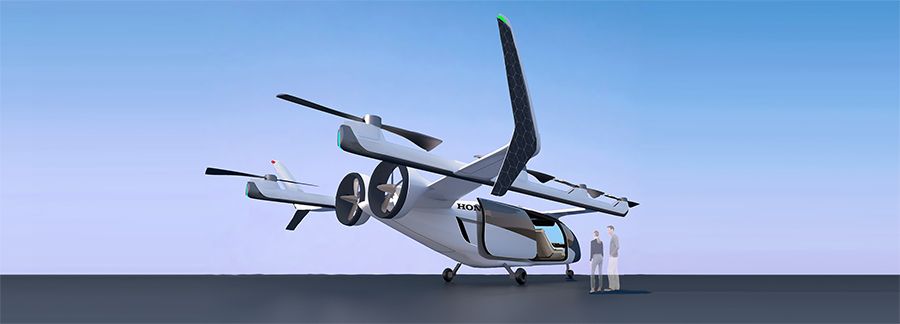Honda announced on Thursday that it is developing a hybrid-electric vertical takeoff and landing (eVTOL) aircraft. The aircraft will be aimed at providing city-to-city transport, a market the company believes will grow significantly in the future. Honda also plans to create a “mobility ecosystem” that will focus on coordinating and integrating the eVTOL with ground transport.
“All-electric eVTOL aircraft face a range issue due to limited battery capacity, therefore the realistic use area is limited to intra-city (inside city) transportation,” the company said. “To address this issue and realize user-friendly inter-city transportation with longer range, Honda will leverage its electrification technologies and develop Honda eVTOL equipped with a gas turbine hybrid power unit.”
According to Honda, the aircraft will feature “a wide range of Honda’s core technologies” developed in areas including combustion, aerodynamics and control. Planned performance numbers for the design have not yet been announced. It has been reported that Honda is aiming to being flight testing its eVTOL in 2025 with a certification target of 2030.




































Interesting.
Honda has been very reluctant to jump on the EV bandwagon. Similar to Toyota and Mazda
They will certainly be forced into it soon enough though.
Honda has aviation expertise, and superior engineering ability so I suspect they have a better chance than some startup person making RC gliders in his mother’s basement, although the laws of thermodynamics still apply.
Remember “Day Jet” and the VLJ debacle. I see this as very similar. The technology is NOT there yet. Keep making gliders in your mothers basement until we push that battery tech to where it needs to be.
Apples and oranges. DayJet went under due to financial problems, not because of unrealized technology. The Eclipse performed as advertised, DayJet’s business model did not.
“All-electric eVTOL aircraft face a range issue due to limited battery capacity”
Finally! A company developing a new VTOL that operates in reality. Battery-operated eVTOLs will never compete on range, and the venture capitalists throwing money at eVTOL startups don’t seem to understand that.
Exactly. The basic rules of chemistry in the periodic table indicate that light weight/high capacity batteries of the energy capacity necessary to replace true fuels is not possible. All they could do is short hops. I respect Honda recognizes this and states it upfront.
Savvy AvWeb readers realize the comments above–despite a “plethora of press releases” from start-ups–the mainstream manufacturers (those that have ACTUAL EXPERIENCE in creating aircraft to FAA specifications) have for the most part yawned and elected to NOT throw money at this pipe dream–leaving the daydreaming to the amateurs.
I read AvWeb every day–it’s the best source for industry updates–but I wish AvWeb would create a separate “press release” section so we could opt out of these “wanna-be” proposals–OR, at our option, allow ourselves the vicarious view of “The Far Side” of aviation.
Honda is an amazing company with breathtaking engineering and manufacturing capabilities. However the Honda Jet program took around 20+ years from inception to certification, and utilized mature technology that have a well understood certification basis, and they partnered with industry leader GE on the engines. You get a $5m aircraft with around $1,300 /hr operating costs. They spent more than $1 billion on the program and it is unclear how this will ever turn a profit.
My point being even if you know the rules, are using existing mature technology, are the best in the world in engineering and manufacturing, partner with world leading engine experts, and have all the money in the world, it still takes decades to get this done and you don’t make any money.
So if Honda is doing this to prove they can do it, and have the corporate discipline to see how this will benefit them in 20+ years, that makes sense. What does not make sense are these endless AvWeb articles saying that this stuff is around the corner and will be available to the masses in a handful of years. If you disregard all of the areas of power/weight, infrastructure gaps, simple economics, range, maintenance, reliability, safety, automation integration, airspace integration, legal liability framework etc. and focus JUST on the regulatory approval of a non-automated aircraft, is this realistic?
If you put a completely new regulatory framework in place not based on the rules from 40+ years ago, yes maybe you can get Honda eVTOL safely certified in under nine years. Some are fine with throwing the FAA out the window (who likes them anyway? it’s just a bunch of old white males). The existing regs are convoluted path which somehow delivers impressive safety in what it certifies. Is it all needed or can we get rid of some of that overkill? Enormous policy changes are needed to successfully make this vision a reality, and just requesting special equivalent safety rule deviations for each certified component doen’t get to the root of the impediment of gaining approval of disruptive technologies in aviation.
But under the current regs and deviation approval process for e-vehicles, this Press Release’s timeline is not realistic, since getting something like a new jet with existing, proven tech would be a hard stretch to certify in that 2030 timeline.
An eVTOL project with hundreds of new technologies would not be realistic to get certified in 9 years (even without all the levels of automation envisioned). An aviation reporter knows all of this obviously , but we keep seeing these stories every few days because we like concept art and they are effective clickbait to put eyeballs on ads. Let’s just all agree to ignore them until there’s some reporting with some honest effort is provided to put this in context of the regulatory reality.